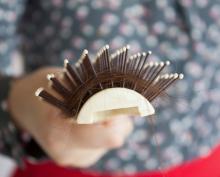Is it Really "Alopecia?"

I get a lot of questions like:
“How do I know this is alopecia?”
“I don’t have an official diagnosis—is it still alopecia?”
“I have diffuse loss—could it be alopecia and will your program help me?”
“I have female pattern baldness—is this alopecia?”
It’s all “alopecia” because the medical term for hair loss (any pattern—total, patchy or diffuse) is “alopecia.” But many medical experts refer to alopecia specifically as autoimmune hair loss. The term is used somewhat loosely and interchangeably, which can be confusing.
I’ve worked with a few clients with female pattern loss, also known as female pattern baldness (FPB) or androgenic (or androgenetic) alopecia. Some in my Reversing Alopecia course have this specific pattern, which is the most common form of hair loss for women.
It typically shows up as thinning along the top part (sometimes to the point of baldness in that area), thinning on the sides (mostly around the temples), and diffuse loss elsewhere on the scalp.
You can go here to see images according to the Ludwig Scale >
One misconception is that female pattern loss causes a receding hairline similar to men. This isn’t usually the case—if a woman is losing hair along her hairline at the forehead, it’s often frontal fibrosing alopecia, which may or may not present with visible scarring or a fibrous look to the skin in that area.
There’s often, but not always, an autoimmune component to androgenic alopecia as well. Yes, diffuse loss can be part and parcel of androgenic alopecia, but sometimes there’s some alopecia diffusa in the mix.
I know, it’s enough to make you want to throw your hands up. BUT…many of the same strategies help to improve alopecia, no matter what the pattern. Yes, you read that right.
And yes, androgenic alopecia is somewhat of an outlier in that it’s largely associated with androgenic hormones (DHEA, testosterone, and DHT), but I’ve found that this doesn’t tell the whole story for many with the androgenic pattern—they also need to address things like systemic yeast, hydrochloric acid status, blood sugar status, estrogen dominance, and low ferritin, to name a few. (All “deal breakers” in getting your hair back.)
Additionally, those with patchy or total loss can also have an androgen imbalance.
See, it’s all interrelated.
Doctors frequently tell people suffering from alopecia patterns such as areata, totalsis, universalis, or ophiasis, that “there’s nothing to be done about it” or that we have to “live with it” (if they’re not already prescribing questionable drugs that can make the situation worse in the long term). And they say the same thing about androgenic alopecia, even though they consider it somewhat separate from the other patterns. (And again, it is an outlier to some degree.)
Here are some specific—and often unknown—factors to consider for the androgenic pattern:
- Both high and low androgens can cause hair loss.
- Long-term and/or high-dose ibuprofen use can tank androgens. (These studies were done on men, but in talking with Dr. Greg Plotnikoff about it, he said that it’s likely that we can extrapolate this for women. He said, “Those studies just haven’t been done yet.”)
- Testosterone naturally converts to DHT (a testosterone metabolite also known as “the hair muncher”) via an enzyme called 5-alpha reductase (5-AR). Just because you have low testosterone doesn’t mean that some of it isn’t getting converted into DHT, which, by the way, is 3-5 times more potent than testosterone.
- “Miniaturization” of follicles is largely due to DHT. The other primary factor is genetics. But that doesn’t mean that you have to live with it.
- High DHT is also provoked by estrogen dominance and high cortisol.
- Speaking of estrogen, the androgenic pattern is often related to problems with estrogen metabolism (which can lead to estrogen dominance).
- Androgenic hair loss is often associated with PCOS. And get this—there’s a male equivalent of PCOS; one studyfound that men with premature male pattern baldness had hormonal profile similar to women with PCOS, including significantly higher insulin resistance.
- Saw palmetto and pumpkin seed oil block both 5-AR and DHT. Talk about catching two butterflies with one net.
- Essential fatty acids inhibit 5-AR and DHT production (1, 2)—it’s said to be a “nutritional bombshell” and to even work better than Finasteride!
- Because androgenic alopecia is “an aberration of the normal hair cycle,” it’s theoretically reversible (despite what the medical community will tell you).
Again, most of the women I’ve worked with who have the androgenic pattern have more going on than just an androgen imbalance. For example, they’re often estrogen dominant and diffuse hair loss is one of the hallmark symptoms of hypothyroidism/Hashimoto’s and there’s often a thyroid imbalance thrown in there.
And yes, genes play a role, but we have the power to turn bad genes off and turn good genes on with the powerful and exciting science of epigenetics.
If you have the androgenic pattern and you’ve gotten nowhere, take heart. The good news is there’s much more to it than you’ve likely been told—you don’t have to JUST obsess about androgenic hormones. And these other contributing factors, once brought to light, can often be managed.
When they are, and the inflammation (which also causes miniaturization) in the follicles is reduced, it’s entirely possible to see a lot of improvement. Addressing these imbalances along with androgen management can also have a FAR-reaching and positive impact on the whole body.
* * *
Go here for my alopecia interview with Alopecia Life >
Go here for my alopecia interview with Rebuilding My Health >
Comments
Any thoughts regarding hair
Any thoughts regarding hair loss and one years of age on half the head and came back until 17 and then all gone since now 67
Add comment